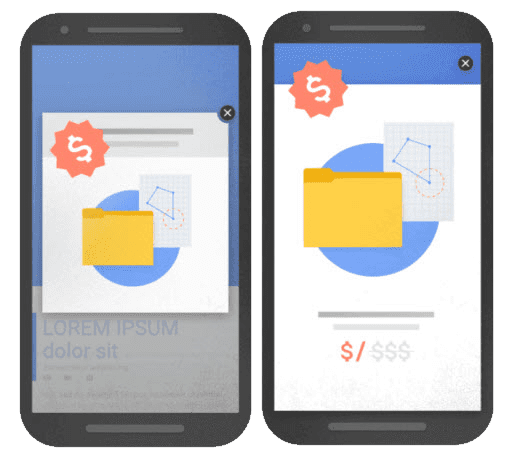- - SEO - Google Update - SEO - Google Update - SEO - Google Update


THANKFULLY WE’RE PAST THE DAYS OF POP UP AFTER POP UP JUMPING OUT AT US WHEN WE CLICK ONLINE, UNLESS YOU’VE GOT A DODGY VIRUS HIDING SOMEWHERE IN YOUR HARD DRIVE. HOWEVER, A WEBSITE POP UP CAN BE A REALLY USEFUL TOOL FOR YOUR BUSINESS AND THEY HAVE IMPRESSIVE CONVERSION RATES TOO.
Optimonk’s research shows the conversion rate for pop ups scores very highly at around 11.09% and this is pretty useful if you’re trying to drive more business through your website. The problem you’ve got is Google really isn’t a fan of certain pop ups. It is actively devaluing websites featuring what they define as intrusive pop ups, so if you want to get what you can out of pop-ups how can you do so without incurring the wrath of the gods of search? Read on to find out.
Google announced its mobile interstitial penalty back in 2017 and it refers to what it calls intrusive interstitials. Simply put, Google does not like websites which ruin user experiences with intrusive ads and pop ups, especially in the case of mobile interstitials. The best way to understand this is to give some solid examples of pop ups which you should avoid at all costs:
This is your checklist for things not to do with a website pop up – but what can you do? Here are three ways you can use pop ups as part of your SEO strategy. We’ll start by showing you the examples used on Google’s own website, the below are examples of those ugly, annoying, in-your-face pop ups. Everybody hates these, particularly Google, so don’t do it. What can you do then? We hear you ask. Stick around and find out….

Google doesn’t like those intrusive pop ups so to stay in their good books but still enjoy the benefits of this kind of advertising you’ve got to create non-intrusive interstitials.
Non-intrusive pop ups include those essentially required elements such as age verification interstitials or cookie usage pop ups. You can also comfortably use pop ups which take up less than 15% of the screen and don’t inhibit your user’s experience. These kinds of pop ups cover all kinds of options including banner ads, slide-ins and tabs, as long as you remember that 15% rule. There also needs to be a clear way users can quickly click off your pop up, so make sure those Xs are clear on your ads.
Against Google’s Guidelines: anything which blocks out most or all of the screen.
An acceptable amount of screen space used by a pop-up on mobile: the below is the only kind of pop-up size on mobile Google says is okay.

The below example is a pop-up we implemented for our client PP O’Connor: the message is extremely important so we felt placing it at the top was justified, however, it is not intrusive and still allows for the full usage of the website without even having to click the X.

The below example is a really cool offer pop-up which we have implemented for our client Perfume Direct: it’s subtle and doesn’t impact the user journey at all, however, once you start scrolling the site you can’t miss it.

If those big pop ups are an essential part of your strategy, then you need to look at the timed pop up option. Timed pop ups can be a little risky but if you’re careful they can definitely work. If you’re not careful, all the work you’ve done on your website’s SEO can go down the drain.
Timed pop ups should be used strategically to avoid the risk of being considered intrusive. Instead, be strategic with your pop ups and time them so they appear a few seconds after people arrive on your website, giving them a little time to engage with your content first. For example, if your pop up appears 10 seconds into someone visiting your site, you’re much less likely to be penalised than if you have it appear at their first click. It’s worth spending some time testing different timings for your pop ups to see which is most effective.
Google’s John Mueller has explicitly said that exit-intent pop ups will not attract a penalty from the search engine, so they’re a great choice for your strategy. Exit-intent pop ups appear when a user is already trying to leave your site, so it does no harm to try one last time to tempt them back or push them towards some more of your added value content.
Exit-intent pop ups usually include links to white papers, case studies or specifically designed lead magnets that stop users from clicking that X and instead result in them heading to your landing page

Google is actively penalising businesses that think they can get away with intrusive interstitials on their websites. (As you can see in the above image courtesy of the guys over at Ezoic.com.) However, we’ve seen just how valuable the conversion from them can be, so finding a way around the penalty risk could be beneficial to your business.
If you’re worried about the impact of a pop up you’re planning, keep the end user in mind, just how much will your pop up impact their experience of your content? User experience trumps everything, and if your pop up ads are ruining their time on your site, you can’t expect them to return.
How do you use pop ups on your site? If you’re not sure whether you’re toeing the line, we can help keep your strategy on track. Contact us today if you fancy a chat, if you enjoyed this blog you can check out more of our articles here.
Give us your email and we'll do the same thing every other performance marketing agency does... never email you.